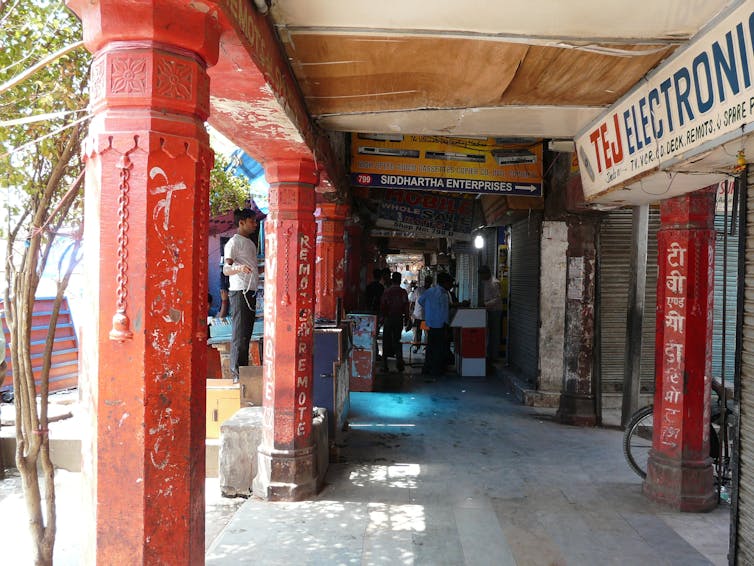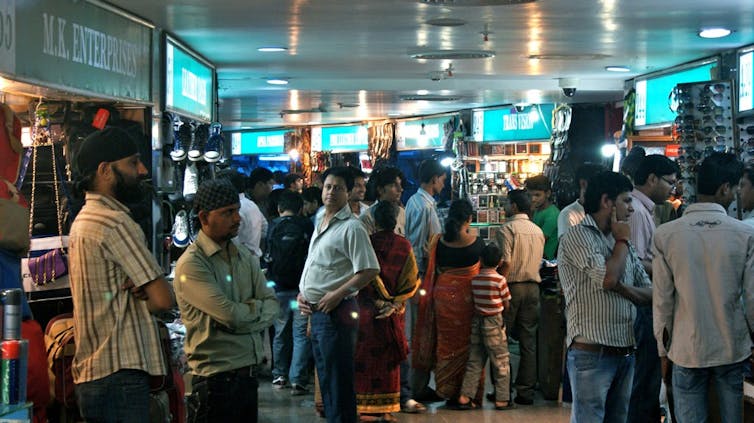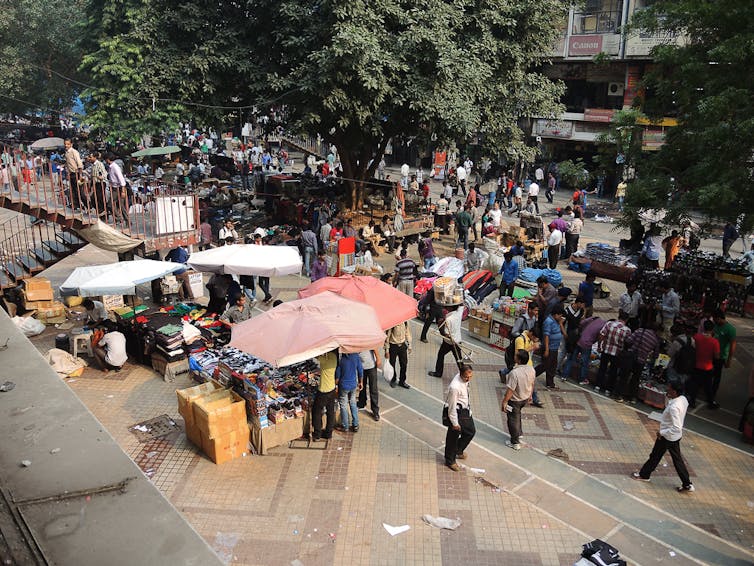Contemporary characterisations of squatters and street vendors as a “nuisance” reproduces colonial urbanism ideas of hygiene and order.

Public life in India, and South Asia more broadly, centres around the working-class camaraderie of an adda or gathering: people sitting and chatting often under a tree or at a tea stall.
In Delhi, the wealthy upper-middle classes have long flocked to new malls and supermarkets. The urban working classes, however, still favour the city’s bazaars, for the space they allow for both adda and for making a living.
The virtual economy, with its digital platforms, cashless payment systems and online shopping, has of course seen street-level economies, across the globe, decline. However, as I show in my book, Traders and Tinkers, bazaars remain dynamic public squares that have long fostered new forms of popular culture.
From the pirate CD industry to fashion knock-offs and DIY electronic goods, bazaars have nurtured a significant informal economy. These marketplaces affirm the existence of people – daily wage earners, pullers and loaders, small-scale tradesmen and street vendors – who live and work on the margins of society.

Since 2012, I have conducted ethnographic research in three of Delhi’s marketplaces: Lajpat Rai market, Palika bazaar and Nehru Place. I have interviewed traders and vendors. I have taken part in addas. I have observed sales in shops and on the street.
In 1957, the Delhi Development Authority was established as part of the Ministry of State Housing and Urban Affairs. This statutory body devised what was known as the “master plan” of 1962 – an ambitious, modernist urban zoning project which divided the city into residential, commercial, work and industrial complexes.
Implementing the plan became difficult as the initial enthusiasm for building functional spaces faded. There was a fundamental difference between how ordinary people used these spaces and what planners had in mind.

Instead of the ideal consumer spaces of orderly shops and civic transactions, ordinary people traded in the nooks and crannies of informal marketplaces. Bazaars emerged as unruly, chaotic spaces. There you could haggle for better prices. Anyone – slum dwellers, new migrants, unemployed youths – could find a way to survive.
This highly competitive, face-to-face economic exchange sits midway between the opaque world of high finance and the routines of everyday life.
In the 1970s, Delhi’s electronic bazaars were where most people went to buy radio and electrical equipment. In the 1980s, vendors shifted to TV sets, VCRs and gaming consoles, as so-called suitcase entrepreneurs smuggled media products into the country and made them available to the broader public, despite official restrictions on imported products remaining in place.
After trade was deregulated in 1992, foreign products became more widely available and bazaars lost their monopoly. However, piracy – in computers, consoles, games and software – emerged as a lucrative way to attract those consumers who could not afford to buy originals.
A market for DIY assembled computers emerged in Nehru Place, to the south of New Delhi. People started selling unlocked gaming consoles so that you could play the latest games on older models. Vendors stocked pirated movies, software and games on cheap CDs and DVDs that cost half the price of new products.

The bazaar facilitates what author Ravi Sundaram terms a “pirate modernity”. These everyday practices of recycling, remixing and copying media products in postcolonial India comprise both benign private consumption trends and more insidious forms of media circulation. Sundaram cites the example of far-right Hindu actors taping vitriolic messages on cassette tapes for broader circulation.
The German artist and author Hito Steyerl talks about “swarm circulation” to describe this kind of unofficial, underground copying. In facilitating this type of pirate economy – that relies on unsteady internet connections and DIY desktop computers bazaars – bazaars represent an alternative infrastructure. This is evident in both the way they spread out and the aesthetic they cultivate.
New business ventures can crop by the side of an existing shop, against a pillar, out on the pavement, down an alleyway. In Lajpat Rai market, I witnessed a young vendor at a desk by the roadside operating an on-the-spot repair station. He used scavenged parts from abandoned machines to fix a customer’s PlayStation 3 console.

This offers a crucial counterbalance for working-class people in Delhi. Street vendors largely live in the city’s shantytowns or slums where space is at a premium and the threat of demolition is constant.
Further, the very broad range of customers bazaars host nurtures a unique aesthetic. Clothing on sale might feature heaps of accessories, from zippers to rivets. One knock-off garment might boast multiple brand logos. On display counters, you might find 1980s TV games and cassettes alongside the latest gaming consoles.
Dehli’s bazaars do not align with any top-down approach to urbanism that prioritises order and cleanliness over makeshift economies. And precisely because of this, since the 1990s, the government has increasingly cracked down on them.
Sociologist Amita Baviskar uses the term “bourgeois environmentalism” to describe these official clean-up operations in Delhi. She underlines that this contemporary characterisation of squatters and street vendors as a “nuisance” reproduces colonial ideas of hygiene and order. British colonisers too initiated clean-up operations in working-class neighbourhoods, citing overcrowding and poor ventilation.
Today, street vendors in Delhi also have to contend not only with raids but how gentrification is changing local neighbourhoods. Their livelihoods are also under threat from the competition online shopping and e-commerce platforms have posed since the 2010s.
So far, though, people have found ways to adapt. Some are moving away from street-level to occupy similarly informal e-commerce platforms and social media marketplaces.
Delhi’s electronic bazaar are like sponges. They absorb different types of labour and product. They foster processes of dismantling and reassembling. As dynamic public spaces, they are invaluable.
Maitrayee Deka does not work for, consult, own shares in or receive funding from any company or organisation that would benefit from this article, and has disclosed no relevant affiliations beyond their academic appointment.